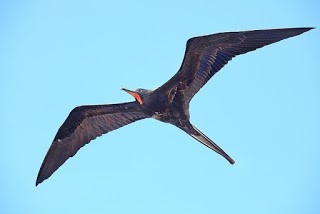- Home
- >
- Albatross
The frigatebird, also known as the man o' war bird, does not sleep while flying. However, it has the ability to rest and even nap while gliding. This behavior is called "power-napping," where the bird shuts down one hemisphere of its brain while the other remains alert for navigation and flight control. This allows the bird to rest and conserve energy while remaining airborne.
To understand how frigatebirds sleep and for how long during their flights, scientists have used techniques such as electroencephalography (EEG), Global Positioning System (GPS), and 3D accelerometers to monitor their brain activity, flight altitude, and head movement. Out of the 14 frigatebirds monitored, each bird went on one or two foraging trips during the monitoring period, covering distances of around 3,000 kilometers.
Firstly, let's explore whether there are differences in their behavior during daytime and nighttime flights. The monitoring results show that frigatebirds flap their wings less during the night, approximately half as frequently as during the day. In terms of flight altitude, they reach their highest point about an hour before sunset and gradually descend. This pattern is not observed during daytime flights.
Next, let's examine if they sleep during nighttime flight. The research team found that when frigatebirds are gliding on thermals, they sometimes enter a brief state of slow wave sleep, evidenced by slow-wave brain activity. During gliding, their head position remains relatively motionless, and when their head moves rapidly, the slow waves disappear. This suggests that the short episodes of slow-wave sleep during gliding truly indicate sleep. Occasionally, both hemispheres of their brain enter rapid eye movement (REM) sleep simultaneously, with the birds' heads drooping and twisting, resembling REM sleep on land. However, this phenomenon occurs infrequently.
Overall, frigatebirds are more likely to enter sleep when riding thermal updrafts and remain awake when descending. Sleep during flight includes periods of unihemispheric sleep, which accounts for 47% of their flight time, while on land, unihemispheric sleep only constitutes 25%.
Lastly, let's consider how long they sleep in a day during flight. The study found that although frigatebirds spend more than half of their time sleeping on land (53%), they sleep for less than 3% of their time (2.89% or about 41.6 minutes) during flight! Furthermore, in this limited and fragmented sleep time, almost half of it involves only one hemisphere of the brain sleeping. It is truly remarkable how frigatebirds can regulate their sleep in this manner. If we were to stay up for ten days and drive 3000 kilometers, only sleeping for less than an hour each day and with only half of our brain sleeping, we would probably end up driving into a river or a field...who knows? It's a scenario that I prefer not to imagine!
Reference:
- Rattenborg et al. Evidence that birds sleep in mid-flight. Nature Communications 7, Article number: 12468 (2016) doi:10.1038/ncomms12468
Author: Green Yeh
Assistant Professor, Department of Life Science, Tzu Chi University, Science Education Center contributor, engaged in writing popular science articles.

